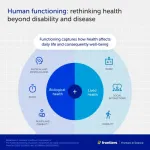(Press-News.org) Some foods and medicines, such as many COVID-19 vaccines, must be kept cold. As a step toward a robust, stable technique that could indicate when these products exceed safe limits, researchers in ACS Nano report a class of brilliantly colored microcrystals in materials that become colorless over a wide range of temperatures and response times. As a proof of concept, the team packaged the color-changing materials into a vial lid and QR code.
Walk-in freezers and refrigerated trucks generally maintain their set temperatures, but accidents can happen. Wireless sensors can monitor the temperature of individual products, but these devices produce a lot of electronic waste. Recently, researchers have suggested using materials that act as visual indicators to provide this information with less waste. Yet some current options using colorful reactions or dyes produce hues that can fade. Or they only track above-freezing temperatures, which isn’t useful for some COVID-19 vaccines that can actually start breaking down below freezing — above -4 or -94 degrees Fahrenheit. So, Yadong Yin, Xuemin Du and colleagues wanted to develop a better color-changing material with tunable melting to track a wide range of temperatures.
The researchers used structural colors, instead of dyes, for their indicator system. The team made glycerol-coated silicon dioxide nanoparticles, which appeared bright green or red when they clustered together into microcrystals in water. Next, they created liquids with variable melting points by mixing different proportions of polyethylene glycol or ethylene glycol and water. When these two parts were put together, they could produce an irreversible color loss when the temperature-triggered solution melted and the microcrystals broke apart. The materials could be customized to track temperature exposures from -94 to +99 degrees Fahrenheit that lasted from a few minutes to multiple days. In other experiments, the two-part indicator systems were packaged into flexible round vial labels and a QR code. These systems were very sensitive and successfully indicated when the materials got too warm. The researchers say that structural color-changing materials hold promise for the diverse scenarios encountered in medical cold supply chains.
The authors acknowledge funding from the National Natural Science Foundation of China, the National Key R&D Program of China, the Youth Innovation Promotion Association of Chinese Academy of Sciences, the Guangdong Regional Joint Fund-Key Project, the Chinese Academy of Sciences Key Laboratory of Health Informatics, the Shenzhen Institutes of Advanced Technology and the Fundamental Research Program of Shenzhen.
The paper’s abstract will be available on May 31 at 8 a.m. Eastern time here: http://pubs.acs.org/doi/abs/10.1021/acsnano.3c00467
The American Chemical Society (ACS) is a nonprofit organization chartered by the U.S. Congress. ACS’ mission is to advance the broader chemistry enterprise and its practitioners for the benefit of Earth and all its people. The Society is a global leader in promoting excellence in science education and providing access to chemistry-related information and research through its multiple research solutions, peer-reviewed journals, scientific conferences, eBooks and weekly news periodical Chemical & Engineering News. ACS journals are among the most cited, most trusted and most read within the scientific literature; however, ACS itself does not conduct chemical research. As a leader in scientific information solutions, its CAS division partners with global innovators to accelerate breakthroughs by curating, connecting and analyzing the world’s scientific knowledge. ACS’ main offices are in Washington, D.C., and Columbus, Ohio.
To automatically receive news releases from the American Chemical Society, contact newsroom@acs.org.
Follow us: Twitter | Facebook | LinkedIn | Instagram
END
Color-changing material shows when medications get too warm
2023-05-31
ELSE PRESS RELEASES FROM THIS DATE:
Metal shortage could put the brakes on electrification
2023-05-31
As more and more electric cars are travelling on the roads of Europe, this is leading to an increase in the use of the critical metals required for components such as electric motors and electronics. With the current raw material production levels there will not be enough of these metals in future – not even if recycling increases. This is revealed by the findings of a major survey led by Chalmers University of Technology, Sweden, on behalf of the European Commission.
Electrification and digitalisation are leading to a steady increase in the need for critical metals* in the EU’s vehicle fleet. Moreover, only a small proportion of the metals are ...
Spinosaur Britain: Multiple different species likely roamed Cretaceous Britain
2023-05-31
Analysis of a British spinosaur tooth by palaeontologists at the EvoPalaeoLab of the University of Southampton shows that several distinct spinosaur groups inhabited Cretaceous Britain.
Stored within the collections of the Hastings Museum and Art Gallery in East Sussex, the fossil that forms the basis of the new study was gifted to the museum in 1889. It was collected from the local Lower Cretaceous rocks of the Wealden Supergroup, a thick, complicated rock sequence deposited across south-eastern England between 140 and 125 million years ago.
The ...
IMDEA Software and IMDEA Networks work to deploy in the Community of Madrid "MadQCI": Europe's largest quantum network
2023-05-31
IMDEA Software and IMDEA Networks Institutes participate together with six other partners (Instituto Nacional de Técnica Aeroespacial, Centro Español de Metrología, Fundación Vithas, Universidad Autónoma de Madrid, Universidad Politécnica de Madrid and Universidad Complutense de Madrid) in the MADQuantum-CM project, funded by the Community of Madrid, the Spanish State through the Plan for Recovery, Transformation and Resilience, and the European Union through the NextGeneration EU funds. The objective ...
1 in 3 adults with Type 2 diabetes may have undetected cardiovascular disease
2023-05-31
Research Highlights:
One-third of adults in the U.S. with Type 2 diabetes may have symptomless or undetected cardiovascular disease.
Adults with Type 2 diabetes who do not have any signs or symptoms of cardiovascular disease are more likely to have elevated levels of two proteins linked to heart disease than peers without Type 2 diabetes. These cardiac biomarkers are associated with an increased risk of death from cardiovascular disease and any cause.
The findings suggest that routine screening for these two cardiac biomarkers and more tailored interventions may help to reduce the risk of cardiovascular disease ...
Heart health is sub-optimal among American Indian/Alaska Native women, supports needed
2023-05-31
Statement Highlights:
In its first scientific statement addressing cardiovascular health in American Indian/Alaska Native (AI/AN) women of childbearing age, the American Heart Association reports that more than 60% of AI/AN women already have suboptimal heart health when they enter pregnancy, which is strongly related to the development of heart disease later in life.
In addition, more than 4 in 5 AI/AN women reported they have experienced violence, and they are disproportionately likely to have also experienced a high number of adverse childhood experiences, which contribute to higher heart disease risk.
Type 2 diabetes is the predominant, traditional cardiovascular ...
New health indicator can revolutionize how we measure and achieve well-being
2023-05-31
The term ‘well-being’ entered popular vocabulary during the Covid-19 pandemic soon after ‘lockdown’ and ‘quarantine’. We quickly discovered that without the ability to take walks, socialize, and work, our well-being suffered. Health was suddenly more than just the state of our bodies – it also depended on our ability to engage in activities that matter to us.
Though this was a revelation to many, the World Health Organization (WHO) had already begun this rethinking of health. It created a new concept and assessment ...
Research calls for changes to state law requiring child protective services to be notified when medications for opioid use disorder are used during pregnancy
2023-05-31
BOSTON—In the United States, federal legislation mandates that all states track data on all newborns who have been exposed to substances during pregnancy and ensure that a plan of Safe Care is created for each family. Yet each state manages those regulations differently.
In Massachusetts, the Department of Children and Families (DCF) has issued guidance that any prenatal substance exposure—including exposure to medications for opioid use disorder (MOUD)—is an indication to file a report for alleged child abuse/neglect upon the birth of the child.
MOUD ...
Actively reducing noise by ionizing air
2023-05-31
Did you know that wires can be used to ionize air to make a loudspeaker? Simply put, it’s possible to generate sound by creating an electric field in a set of parallel wires, aka a plasma transducer, strong enough to ionize the air particles. The charged ions are then accelerated along the magnetic field lines, pushing the residual non-ionized air in a way to produce sound.
If a loudspeaker can generate sound, it can also absorb it.
While this plasma loudspeaker concept is not new, EPFL scientists went ahead and built a demonstration of the plasma transducer, with the aim to study noise reduction. They came up with a new concept, ...
Can phrases like ‘isn’t it?’ or ‘right?’ compromise classroom learning? New study answers
2023-05-31
Classroom education, in an ideal sense, must engage all students in a constructive discussion with the teacher, making it the latter’s responsibility to utilize different inclusive strategies. To bring the attention of distracted students back to the classroom discussion, teachers often have to use different methods to remind them that they are an equal and important part of this shared activity. This task can be tricky since most teachers attend to multiple students in a classroom. What strategies do teachers use to draw the attention of all the students to the ...
Reduced emissions during the pandemic led to increased climate warming
2023-05-31
The Covid pandemic shutdowns in South Asia greatly reduced the concentration of short-lived cooling particles in the air, while the concentration of long-lived greenhouse gases was barely affected. Researchers were thus able to see how reduced emissions of air pollution leads to cleaner air but also stronger climate warming.
It is well known that emissions of sulfur and nitrogen oxides and other air pollutants lead to the formation of aerosols (particles) in the air that can offset, or mask, the full climate warming caused by greenhouse gases such as carbon dioxide and methane. But there has been a lack of knowledge about this ‘masking effect’. ...






